Since the Pho book released, a handful of people have asked if I know how to make fresh rice noodles, if there’s a recipe in the book. I’ve seen them made, and after attempting to make banh pho rice noodles, would rather leave the task to the pros. It’s a craft, a skill and business that traditionally one family develops and passes down from one generation to another. Moreover, making fresh rice noodles is not like making Italian pasta. Rice and wheat flour behave differently since rice lacks the gluten that allows wheat to be easily manipulated.
Pho noodles are flat like those used for pad Thai, cut into narrow strands that range from small (linguine), medium (fettuccine), or large (papardelle). In Vietnam, tender fresh ones are used by pho vendors and sold at open air markets. In grocery stores, you’ll see dried pho noodles.
During my pho research in Vietnam, I wanted to track down a fresh noodle maker. After all, the rice noodles are what carry and convey pho flavor. Made by steaming rice batter into thin sheets and then cutting them into strands, bánh phở rice noodles define pho soup. I wanted a look at old school production and my friends, Tracey Lister and Duyen Phan of the Hanoi Cooking Centre, and Mark Lowerson of Hanoi Street Food Tours, were game. They accompanied me and Karen Shinto for an outing to Nam Dinh city and province and Van Cu village, the purported places where pho got its start.
Mark helped me hire Dan Tran to drive us from Hanoi and be our fixer. I don’t look Vietnamese and though I speak Vietnamese, having a local person facilitate always helps things go a lot smoother.
If you own The Pho Cookbook, you know from the story on pages 14 to 15 that we did not get to sample pho noodle soup on that outing. However, we did get to see the noodles being made.
Through a villager, Dan confirmed the location of a Van Cu pho noodle maker, and we snaked our way through the narrow passageways. The noodle maker’s home was the biggest and best appointed. The family welcomed us once they understood our unusual purpose.
I fantasized that the noodles would be made by hand but that was ridiculous. The family-owned factory made noodles by machine, with a conveyor belt that steamed the batter into thin sheets, which were then machine cut, gathered by hand, and hung to cool.
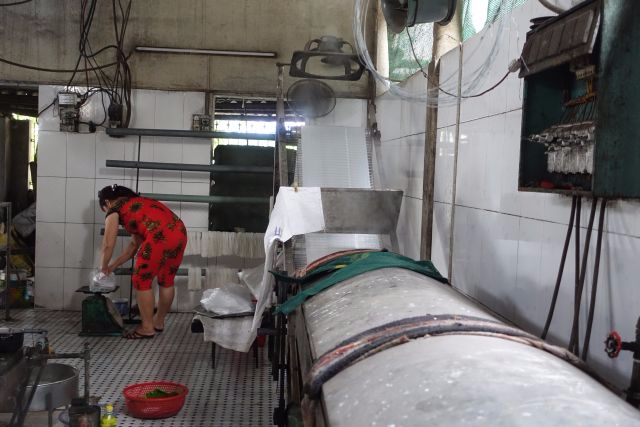
They used to grind the soaked rice by hand, one young man explained. When an electric stone grinder became available, they gladly switched. They select their rice carefully, he said. You don’t want rice that’s too dry or too starchy. Selecting the rice is part of the banh pho maker’s craft and secret.
The same pho noodle maker also made round rice noodles called bun – for other dishes. They distribute their fresh noodles to nearby Nam Dinh city and elsewhere.
A bowl of pho requires a lot of noodles. Over the years, I’ve made banh cuon rice noodle rolls, steamed rice noodle sheets for cheong fun (a dim sum noodle roll), and in The Pho Cookbook, developed a great recipe for pho cuon (page 133) fresh pho noodle rolls stuffed with stir-fried beef, lettuce and herbs. That kind of home cooking adventure is great for an appetizer or snack, but to produce enough for pho and the like requires a lot more patience and skill.
I’d rather buy fresh noodles or use dried ones. Fresh rice noodles should be used relatively quickly or they dry out and break. Making excellent pho broth and readying all the accoutrements (toppings, garnishes, and condiments) require enough concentration and finesse. Why get into the noodle game? Most home and professional cooks in Vietnam don’t make their own banh pho noodles, just like they don’t make banh trang rice paper. To quote Clint Eastwood in Magnum Force, “A man has to know his limitations.”
In Saigon at Pho Hai Thien (a pho mini-chain), there are pho noodles made in-house and naturally stained by vegetable juice. The business specializes in manufacturing the noodle making machine for domestic use.
Outside of Vietnam, there are some pho shops that advertise pho rice noodles made on the premises. The best I’ve encountered was on the outskirts of Southern California’s Little Saigon at Silk Noodle Bar.The co-owners are former engineers who’ve designed a software-driven machine (its size is similar to the one in the Hai Thien video) to make rice noodles. The noodles reminded me of ones in Vietnam but they were chewier. Viet expats favor banh pho rice noodles that are more al dente than the traditional ones in Vietnam, I was told. In Vietnam, pho rice noodles are tender soft.
In San Jose, California, I’ve had fresh banh pho rice noodles at Cong Ly pho shop. When I asked them about their production, they said they bought the noodles from a local pho noodle vendor who also supplied Lion, my go-to Asian market in the area.
Seattle’s Dong Thap has an extensive banh pho and bun rice noodle making operation in the back kitchen. The only time I went there for pho, the noodles were unfortunately broken and dry. It was overall underwhelming, which underscored how difficult it was to deliver fabulous noodles and broth in own bowl – even when the machine is right there.
Having super fresh banh pho rice noodles for pho is not a deal breaker. When I’ve sampled excellent pho in Vietnam and abroad, the noodles were not made in-house. There are options for good pho noodles so why not make incredible pho broth and thoughtfully assemble a knockout bowl? In Vietnam, the pho noodle maker is rarely operating a pho shop, too.
There’s no reason why you should feel that you need to make your own pho noodles for an honest, true pho experience. Understanding how banh pho rice noodles are made is important for appreciating them. Selecting a good pho noodle is key, too! That’s why I'm offering tips on finding good pho noodles in this post. Stay tuned.
Pho Cookbook Updates
We had a fabulous Pho Foodways event at the Jewish Community Center in San Francisco. I was invited to launch the new series for the JCCSF and my friends Jourdan Abel and Thuy Tran masterminded it; Chef Tu David Phu made pho and condiments to serve the attendees. The atrium was packed with about 100 people from all different backgrounds and age groups.
If you're in the Bay Area and a curious supermarket shopper, join me for a fun Whole Foods pho event on March 30.
Eater.com restaurant critic Robert Sietsema did a round-up of New York pho shops and started off his piece referring to the Pho book! Food journalist Carolyn Jung of FoodGal.com test drove the panfried pho noodles recipes. And this weekend, I was on NPR’s Splendid Table radio show with its new show host, Francis Lam. It was an honor and hoot to be on Francis's debut segment.
My editor and publicist attended and both told me that one month out, Ten Speed Press has ordered a fourth (4th) printing! Thanks for the ongoing pho fervor. If you’re willing, leave a review on Amazon or wherever you purchased the book.
Related pho ingredient posts













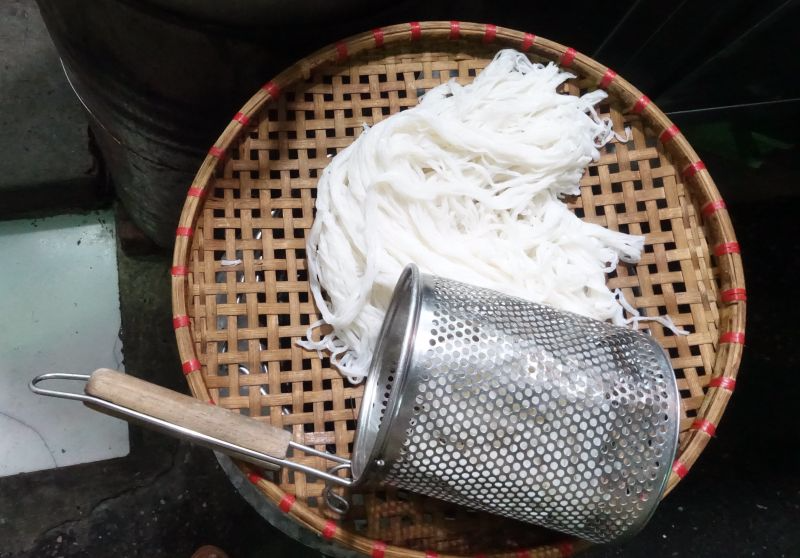
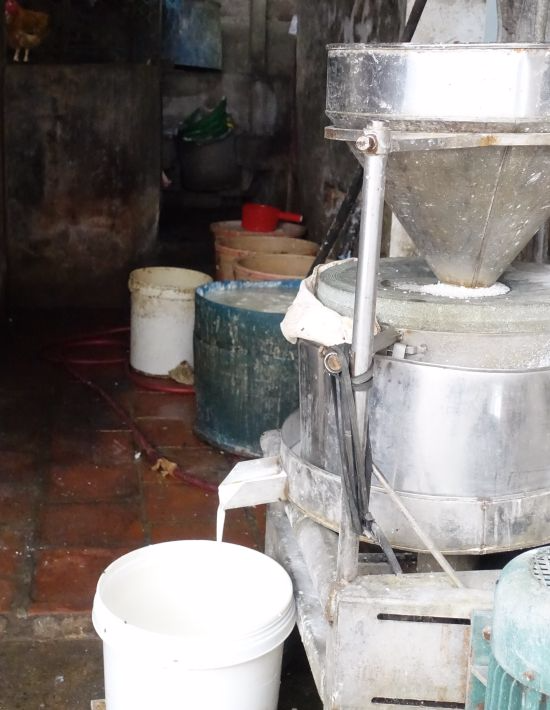
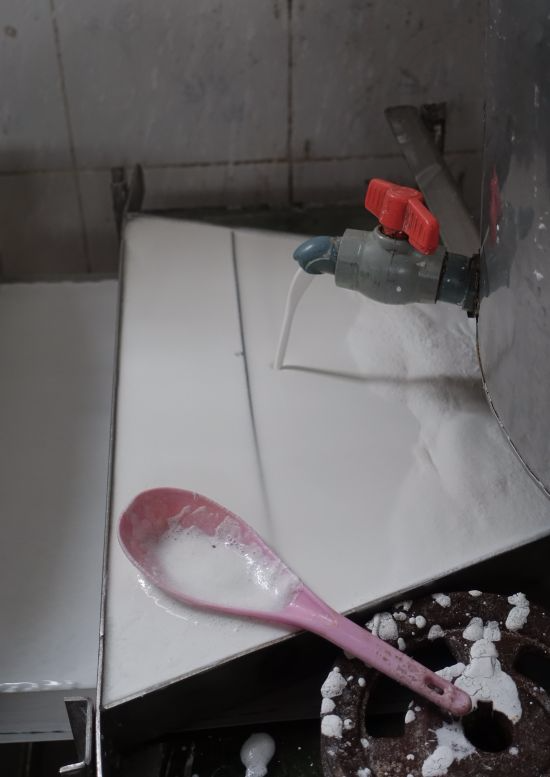
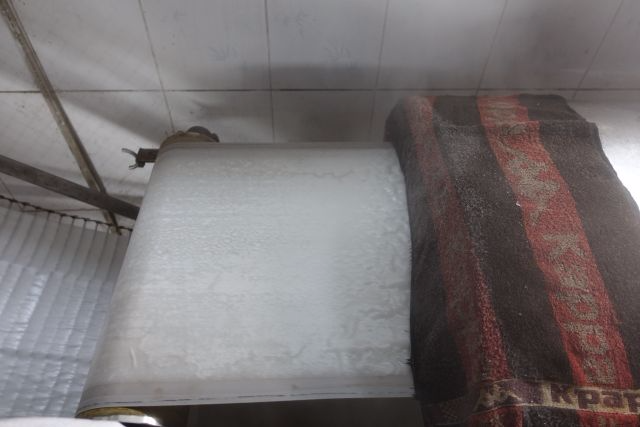
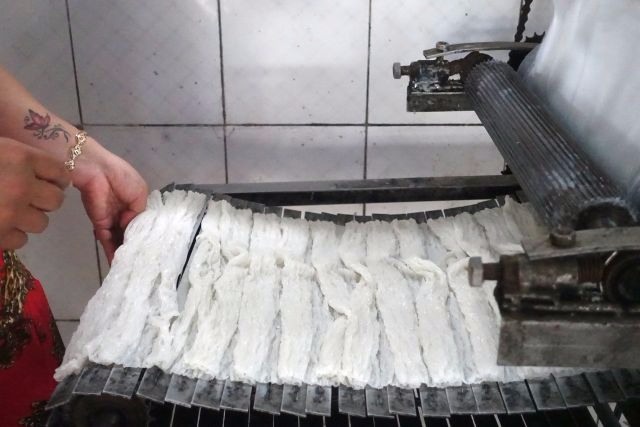
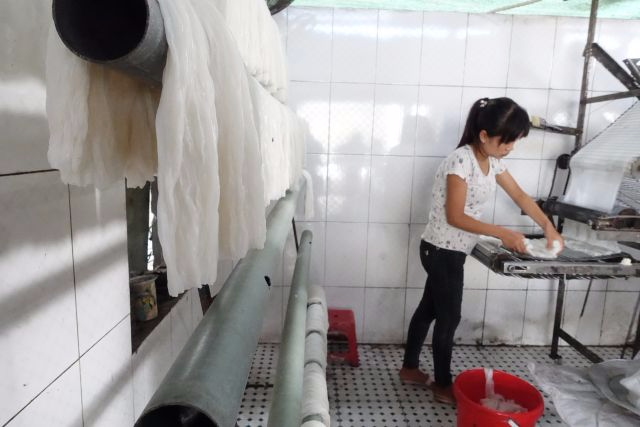
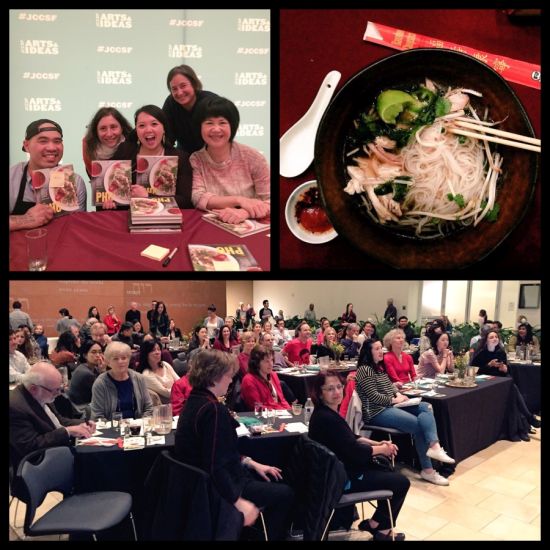




lay sihapanya says
I love pho, but I always wanted to learn how to make fresh noodles from scratch. Do you have receipts and the process. I also want the pho cook book. Where can I buy it?
Andrea Nguyen says
I do not make fresh pho noodles because they are very complicated. Leave it to the professionals. Home cooks in Vietnam do not make pho noodles. They buy them. The information above is from an artisanal shop that's been making noodles for generations. It's a craft that requires lots of labor and equipment. You may want to check out this post:
https://www.vietworldkitchen.com/blog/2017/03/how-to-buy-pho-rice-noodles.html
To purchase The Pho Cookbook, head to a local bookshop or Amazon -- the books will be restocked very soon: http://amzn.to/2oQaMLP
Thank you for asking!
Malcolm McCaffery says
Love your Pho Cookbook. I found out about you when you did a ChefSteps video, since developing a pho addiction, and no Vietnemese restaurants nearby where I live in rural Australia, your book helped me take pho next level 🙂
Andrea Nguyen says
Thank you for cooking up pho in Australia and taking time to write! You made my day.
red says
Rice flour and starch. 3 parts flour, one part starch. add just enough water to make a dough. If you ferment the rice first, the flavor is excellent. Use the best rice you can, steam it, then use the food processor to grind it (might need to add water), and add the starch. put water of stock on to boil, roll and cut the noodles, carefully take them up (I use a pancake turner) and slide into boiling broth or water. Right now, 4 lbs rice have fermented for a week. Time to make noodles and cook them with stock from chicken and veggies that were roasted. walk in beauty.
Malta says
Do you steam the slurry or the whole rice then grind?
Andrea Nguyen says
The slurry is steamed as sheets.
Justin Kauffman says
Hi Andrea, thank you SO much for writing this article! It was incredible. I just sent you an email since I'm in Vietnam myself right now. Cheers 🙂
Andrea Nguyen says
You're welcome, Justin!